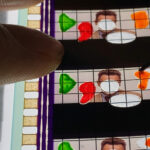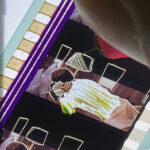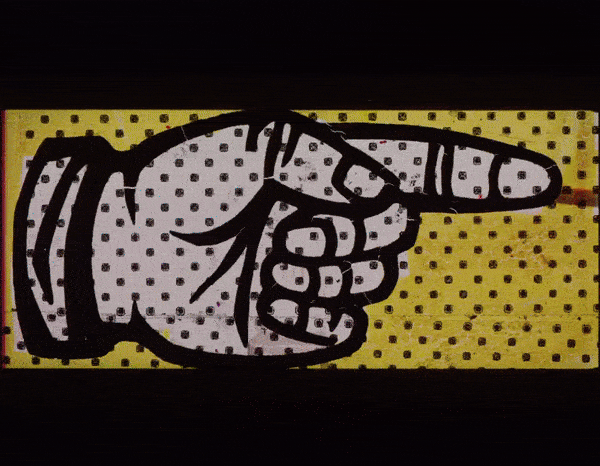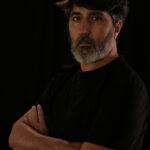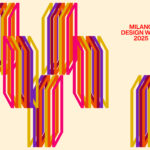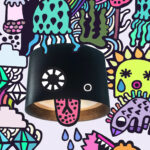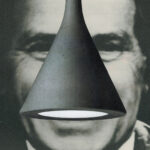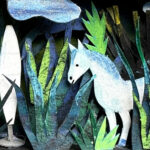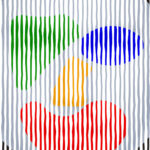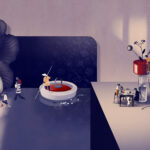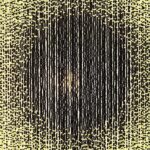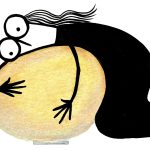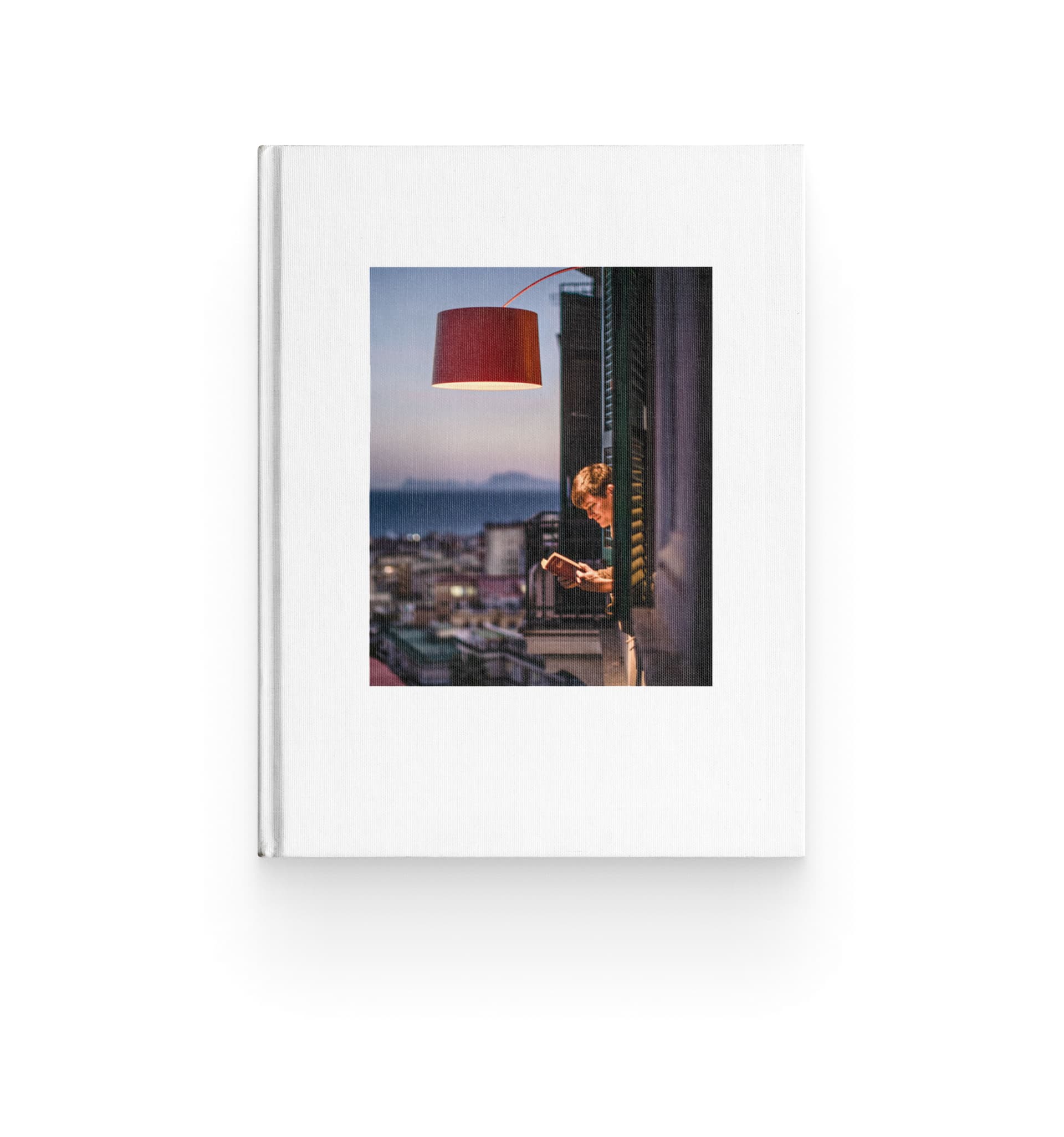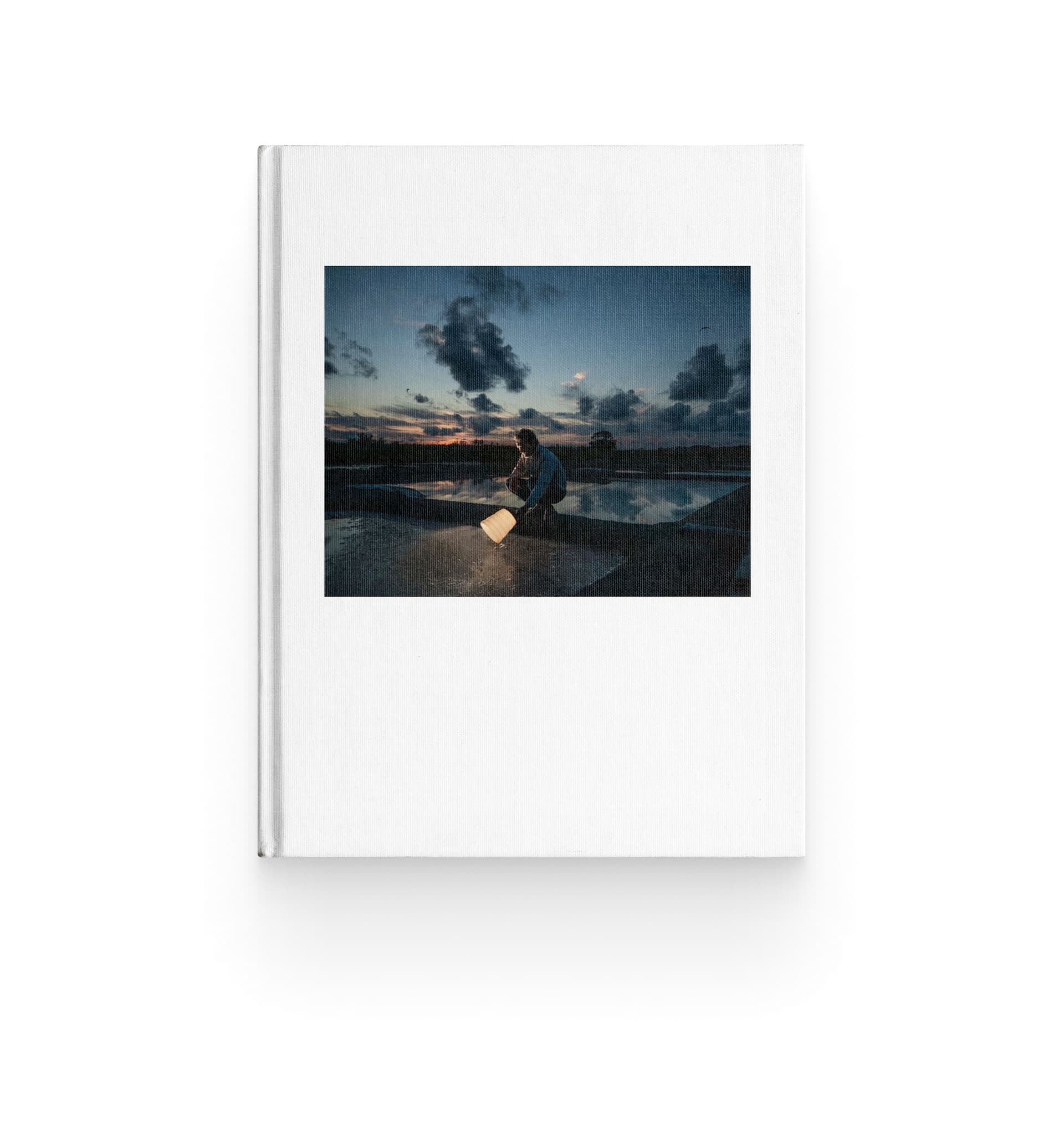Scratches of Light: Bennet Pimpinella’s video art for What’s in a lamp?
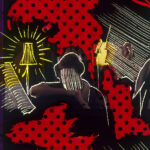
Bennet Pimpinella brings his cinematic art to the What’s in a Lamp? project. Through his signature technique of scratching directly onto film, he transforms Foscarini lamps into symbols of emotions and memories, crafting intimate scenes infused with a surreal, grunge atmosphere.
Exploration and experimentation define Bennet Pimpinella’s artistic journey. Born in 1977 and trained in film at L’Aquila Academy, Pimpinella has spent his career merging analog and digital, continuously redefining the relationship between light and image. His visual language is unmistakable: a blend of experimentation, craftsmanship, and an intimate connection to the medium of film itself. His signature technique—scratching directly onto film—captures his creative process, reflecting its intensity and the emotions it conveys. This instinctive, immediate, raw mark on the celluloid stands as a testament to the intensity of the moment. His works possess a grunge, raw aesthetic, charged with emotion, drawing the viewer into a world where the artist’s personal feelings are palpable.
In his contribution to Foscarini’s What’s in a Lamp? series, Pimpinella transforms light into the main protagonist of his cinematic narratives through his distinctive technique.
“Each of the six films created for Foscarini is unique, but they all share an intimate and emotional mood. Foscarini lamps become symbols of feelings and memories, part of a quiet but deep story. I wanted to combine the materiality of the rough, scratched film with something surreal, creating a dialogue between light and shadow that tells silent, powerful stories.”
Bennet Pimpinella
/ Artist and Director
The soundtrack—created by composer Carmine Calia —does more than accompany the images; it enhances and deepens their meaning. Together, the interplay of light, form, and music in Pimpinella’s work offers a new emotional dimension, forging an intense connection with the audience.
Explore the full collaboration with Bennet Pimpinella and discover the complete series on Instagram @foscarinilamps, where international artists are invited to interpret the theme of light through Foscarini’s lamps as part of the What’s in a Lamp? project.
Tell us a bit about yourself: did you always know you wanted to be an artist? How did your journey into the world of cinema and artistic experimentation begin?
I never imagined I could make a living as an artist, even though I grew up surrounded by art. My father was a painter and sculptor, and my mother was a portrait artist. They always encouraged my love for drawing and painting, but for me, it was something personal, a part of daily life, without ever thinking it could become my career.
After studying as a surveyor, which felt restrictive for my interests, I decided to enroll at the International Academy of Image Arts and Sciences. It was a radical change—suddenly, I was immersed in the world of cinema, discovering a new way to express myself that completely changed my view of art. It wasn’t static anymore, but alive and moving.
I was lucky enough to meet great mentors, like Vittorio Storaro, who played a key role in my development. After graduating, I had the honor of working on his team for ten years, a deeply formative experience. My role was as an assistant camera operator, responsible for loading and unloading 35mm film in the cameras. That’s where I learned to handle and take care of the film. It was during this time that I laid the foundation for my understanding of both the technical and aesthetic aspects of filmmaking. Those years taught me discipline, technique, and above all, a deep appreciation for the pursuit of beauty in images. I still carry those lessons with me today, and I’m grateful to the Maestro Storaro and the entire team for instilling a passion that continues to guide me every day.
What motivates you to create, and where does your inspiration come from? Is it driven by curiosity, a search for meaning, or pure visual expression?
Creating is my way of expressing myself, just as others might write, play music, or sing. For me, it’s something natural, almost instinctive—it’s something I need to do, a way to deal with my feelings. My technique and my work help me understand and express what I’m going through.
My approach is fundamentally experimental: I start with a gesture, with a mark, always seeking something new, yet at the same time, something recognizable. My inspiration doesn’t come from a single source; I draw from everything around me, everything that touches my senses. It could be the blue of the sea, a gray day, a news story, the loss of a loved one, or a melody that captivates me. Every experience, every emotion, transforms into a mark, a shape. I could go on endlessly because everything that moves me has the potential to become part of my creative process.
Your cinema is surprising and unique. How would you describe your style, and how did you develop this distinctive aesthetic?
While I was at the Academy, I explored various forms of cinematic storytelling until I created my first stop-motion animation. That project sparked something in me and led me to dive deeply into the world of animation. I bought books, studied techniques, and experimented with innovative methods—from Alexandre Alexeïeff’s pin screen to backlit glass, Oskar Fischinger’s motion painting, and Jan Švankmajer’s stop motion. Each new discovery fueled my curiosity.
The turning point came when I discovered the direct cinema of Stan Brakhage, which didn’t use a camera. From that moment, I started experimenting with Super 8 film, scratching, coloring, and directly working on the film itself. The most magical part for me was the projection: using a home projector, hearing the mechanical sound of the motor pulling the film, smelling the belts, and watching the dust dance in the light of the lamp… It was an experience that captivated my soul. I still remember the first time I projected one of my works; I immediately knew that this technique would become my language.
Now, after 25 years, I still feel that same excitement and wonder every time the light turns on and the image comes to life. My style is rooted in this blend of experimentation, craftsmanship, and a deep connection to the physical medium of cinema, which remains the foundation of everything I create.
You’ve found a balance between analog and digital, but your work always begins with film. What process do you follow to create your videos? We’re very curious about your techniques, the tools you use, and your working method.
Every project starts with a fundamental choice: the medium. I decide whether to shoot new footage, and once developed, I create a positive to scratch and manipulate, or if I will work with found footage, using existing films to alter.
Choosing the film is crucial and depends on the type of work I’m doing. There are many variables to consider: the format, the perforations, whether the film is already exposed or still unexposed. The brand and age of the emulsion are also important, as they affect the type of scratch I will achieve—in terms of color, depth, and line. Every detail matters in creating the final result.
Once the film is selected, the real work begins, requiring immense patience and dedication. It’s a process that forces you to isolate yourself, as if time stands still. For just one minute of animation, it can take weeks of work. Meticulousness is essential.
In my works, I use a wide range of techniques, and each mark has its specific tool. For scratching the film, for example, I use awls, needles, dental kits, electric grinders, and Dremel tools. But it’s not just about scratching; I cut, paste, and color using every type of material available. The colors range from glass pigments to water-based inks and permanent colors. My goal is always to make the most of what the market offers while keeping creativity at the heart of the process.
A key element of my work is the extensive collection of transfers I’ve gathered over the past twenty years. I have every type and brand, which allows me to explore endless creative possibilities when working with film. Every detail of my work comes from a combination of technique, experimentation, and the desire to constantly challenge the limits of the medium.
How did your collaboration with Foscarini come about, and what motivated you in this work?
When Foscarini approached me to collaborate, I didn’t hesitate for a moment. I vividly remember the excitement I felt as I immediately said yes. Being chosen by a brand I admire while having complete creative freedom was a significant motivator for me. It felt like an opportunity to explore new ideas and create something that resonated with their world but also carried my personal touch.
Whenever I am granted the freedom to express myself, I feel compelled to push my limits, experiment, and seek visual solutions that are surprising and capable of conveying emotions. My aim was to create an atmosphere that reflected the essence of Foscarini while also adding a unique and unexpected element that would resonate with both me and the audience. The challenge of blending my vision with theirs became the key motivation for this project.
In the “What’s in a Lamp?” project by Foscarini, you transformed film fragments by scratching the surface, adding colors, and integrating Foscarini lamps into surreal, grunge-inspired scenes. Could you share the inspiration and meaning that guided you in creating this series?
For the “What’s in a Lamp?” project, I aimed to create a deep connection between light and life. I began the process with a simple yet symbolic act: I turned off all the lights in my home. Then, one by one, I switched them on, searching for the perfect atmosphere to inspire my creativity. Light became my guide, leading to the development of six minifilms.
Each film is unique, characterized by its distinct color and technique, yet they all share an intimate and emotional ambiance. My goal was to tell a universal story where light transcends its physical form and becomes the main character, reflecting our lives. The Foscarini lamps became integral to this narrative, symbolizing emotions, memories, and moments from our experiences. I sought to blend the tangible quality of scratched and colored film with surreal elements, creating a dialogue between light and shadow that conveys silent yet powerful stories.
Is there a particular film from the series that you prefer or hold dear for some reason?
I don’t have an absolute favorite film, but there is one scene that I cherish: the opening shot of Spokes. In that moment, all the intimacy and warmth conveyed by an embrace comes to life. The soft orange glow from the Spokes lamp gently fills the room, enveloping the characters in a glow that transcends mere illumination; it becomes a source of emotion. It feels as this light is nurturing them, protecting them from the surrounding darkness. This scene speaks of connection and protection, embodying that human warmth that goes beyond words, which is what makes it so special to me.
The scratches on the film express all the passion and intensity with which you experience your art. How does your individuality reflect in your works? Do you have a ritual when creating your pieces?
The scratches on the film are my signature—an imprint that captures the entire creative process, with its intensity, imperfections, and that vigorous, instinctive touch that comes from direct contact with celluloid. Each scratch and mark reflects a specific moment in my life and my emotional state at that time. It feels as if the film holds a piece of me and my experiences.
I don’t follow a strict ritual when creating, but I rely heavily on instinct and the flow of the moment. I do have some small habits that help me get into the right mindset. I seek solitude, listen to inspiring music, and immerse myself in a particular kind of light that sets the ideal atmosphere for the journey I’m about to embark on. Each creation is an inner journey, and these habits help me connect with the emotions I want to express in my work.
What is the role of light in your art?
Light is the beating heart of my work; without it, everything would remain invisible. It is the light that brings life to the marks etched on the film, revealing shapes, colors, movements, and emotions.
Light reveals what lies hidden within the material, transforming it into images and, finally, narratives. It is an essential element, a bridge between my creative expression and the viewer’s interpretation. It is the light that brings the artwork to life, revealing what would otherwise remain concealed within the film.
What role does music play in your video art, especially in the “What’s in a lamp?” series?
In the “What’s in a lamp?” series, I invited composer Carmine Calia to join me on this creative journey. He created an unforgettable soundtrack that becomes a character in its own right within the narrative. His music doesn’t simply accompany the visuals; it deeply influences them, shaping the rhythm of the story and adding layers of symbolic meaning. This interplay allows the light and shapes on screen to take on a deeper emotional resonance. Music thus becomes an integral component, capable of forging a powerful connection with the viewer and enhancing the feelings and themes I wish to express.
Do you have any reference artists, masters, or significant influences that have shaped your artistic vision?
I believe my greatest influence comes from my father. From a young age, I grew up watching him paint, and every time he spoke about his art, his eyes would light up. This filled me with joy and instilled in me a deep love for creativity. As an adult, I had the fortune of working with the master of Italian cinema, Vittorio Storaro. Witnessing him at work was one of the most extraordinary experiences of my life. From him, I learned the importance of seeking beauty in the image, a lesson that has profoundly shaped my artistic journey.
How do you nurture your creativity?
I nurture my creativity through a continuous journey of experimentation, often living as a hermit in my home, as if it were my den. Continuously adding to or subtracting from my technique drives me to seek something different while still aiming to maintain a distinctive and unmistakable mark. This desire for evolution and ongoing exploration is the driving force that motivates me to nurture my work.
How would you define creativity? What does it mean for you to be creative?
For me, creativity is freedom. It is a continuous flow that allows me to see the world from different perspectives and express myself in unique ways, always striving to push beyond my limits.
Explore the full collaboration with Bennet Pimpinella and discover the complete series on Instagram @foscarinilamps, where international artists are invited to interpret the theme of light through Foscarini’s lamps as part of the What’s in a Lamp? project.
